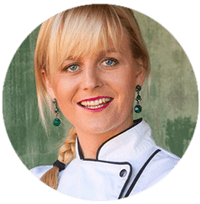Quiche Lorraine
Quiche Lorraine / Kate Martens (p)
“This bacon, onion and cheese tart is always a favourite. I like to use a rich shortcrust pastry (pâté brisée) flavoured with cheese to give it an extra dimension.”
Quiche Lorraine
Makes 2 quiches
Cheese pâté brisée:
- 250 g cake flour
- 50 g Cheddar cheese, grated
- 15 g icing sugar
- 150 g chilled salted butter, cut into cubes
- 1 egg yolk
- 60 ml iced water
- Bacon and cheese filling
- 350 g streaky bacon, chopped
- 1 medium onion, thinly sliced
- 3 cloves garlic, finely chopped
- 15 ml finely chopped fresh thyme or rosemary
- 6 whole eggs
- 350 ml cream
- 250 ml full-cream milk
- Fine salt and freshly ground black pepper, to taste
- 200 g Cheddar cheese, grated
Method:
- Mix together the flour, cheese and icing sugar.
- Add the butter, working it in with your fingertips to resemble breadcrumbs.
- Cut in the egg yolk and water and knead until it comes together.
- Wrap the pastry in clingfilm and place in the fridge for at least 2 hours to rest.
- Roll out the pastry and line two 23 cm quiche tins or flan dishes. Prick the base of the pastry with a fork and place back into the fridge for a further 2 hours, or until cold and firm.
- Remove the quiche bases from the fridge. Blind bake (see page 168) in a preheated oven at 200°C for 25–30 minutes, or until cooked. Set aside to cool.
Bacon and cheese filling:
- Sauté the bacon in a frying pan, until cooked.
- Add the onion, garlic and herbs and cook until the onion is soft, but not brown. Set aside.
- Whisk the eggs, cream and milk together, and add salt and pepper to taste.
- Divide the bacon and onion mixture equally between the two quiche bases.
- Pour over the egg mixture and top with grated cheese.
- Bake in a preheated oven at 180°C for about 45 minutes, or until the custard is set in the centre. Cool slightly, then carefully remove the quiches from the tins and serve.
Pâté brisée is the French term for shortcrust pastry (basic pie dough). Made without sugar (or with only a little sugar or icing sugar added), it is best for savoury tarts, quiches and pies. Pâté sucrée and pâté sablée are terms for sweet shortcrust pastry, most often used in sweet flans and tarts.

